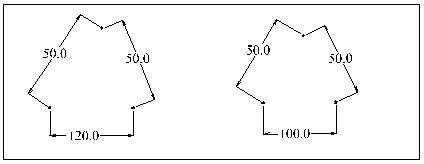More about Analyzing and Resolving Inconsistent Sketches | |||||
|
| ||||
About Inconsistent Sketches
In general, the inconsistent status shows that the user is attempting to make a change to the sketch that is too large. In this context, "large" is relative to the size of the Sketch.
Parts of a sketch may become inconsistent as a result of a number of different operations.
The most common of these are as follows:
- The user changes the value of a dimension. This will normally occur for cases where there would be large changes to one or more geometries.
- The user adds a dimension or constraint to a Sketch, in order to move geometry.
- When dragging geometries, the user attempts to input a large transformation.
- When the geometric type of a use-edge is changed (geometry coming from the projection or intersection of a 3D geometry)
- When there are use-edge large positions or orientations changes.
- When an element of a geometry is deleted (especially in conic curves, connecting curves, spline offsets).
The geometry has not been solved because:
- No solution exists for the current values of dimensions.
- The system cannot find a solution, even though a solution may exist with the current values of dimensions. This occurs when trying to make large changes to under-constrained sketches or to parametric curves (See section Over-constrained and Inconsistent on Parametric Curves below for further details).
- The system has not found any solution that respects the previous chirality.
Chirality determines the way that geometry is positioned relative to the geometries to which it is dimensioned. A dimensioning scheme can often be satisfied by a number of different configurations. The system will always evaluate a new configuration that has the same chirality as the original geometry. It is important to realize that geometry in the system always has an original configuration, which is used for deciding the chirality.
Important:
|
![]()
Resolving Inconsistent Cases
If the inconsistent status code was a result of changing a dimension value, the problem will be resolved by changing the dimension back to its old value. However, in some cases you may want to modify other parts of the sketch to allow the change to be made. The following sections describe different ways that can be tried.
When attempting to solve a problem, the user should focus on the geometries and dimensions in the Sketch with the inconsistent status code.
In order to decide how to avoid the status code it is useful to check first if the problem comes from inconsistent dimensions.
An example of this is a triangle with sides of length 50, 50 and
120.

![]()
Not Changed Status
The not changed status is used in the following cases:
- When geometry becomes over-constrained or inconsistent, the system will not be able to position any other geometries that depend on it. These dependent geometries and their associated dimensions (and any others that depend on them) will be marked not changed.
- Dimensions between two fixed geometry will be given the status code not changed.
- Dimension between two free or one free and one fixed geometry in the same set will be given the status code not changed.